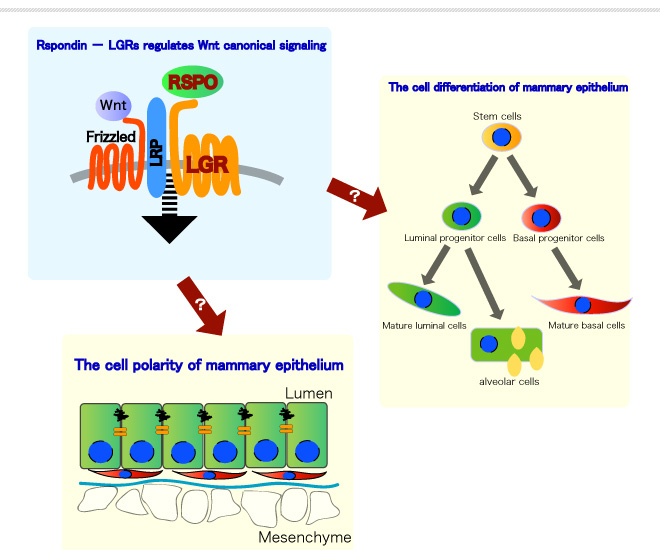|
HOME > Proposed research projects > 2012-2013: Proposed research projects 01
 2012-2013: Proposed research project 01Study of the cell fate in mammary epithelial tissues, directed by Lgr4, the new modifier of Wnt signaling pathway, and its regulatory role in the cell polarity
Project BackgroundWe first generated knockin mice with fx-type Lgr4 gene, which was reported as a GPCR-type orphan receptor, to clarify the function of Lgr4, and observed impairments in various epithelial tissues of the mutant mice. With those studies, we found that R-spondins were Lgr4's potential ligands and important factors in the regulation of the signaling pathways by Wnt/Frizzeld and b-catenin. We also found that Lgr4 contributed to the maintenance of intestinal crypt stem cells, to the differentiation and branching of ureteric tubules and buds, to the development of mammary tubular structure, and to the development and differentiation of the other many epithelial tubular tissues. We’ve also noticed that it might control and maintain the tissue stem cells in those epithelial organs and tissues. Purpose of the Research ProjectTo elucidate the regions/cell where LGR4 and R-spondins are expressed, and signaling mechanism governed by Lgr4-Rspondins. In addition, we would like to further elucidate the mechanism of cell fate decision, and the polarity control system in mammary epithelial cells and tissues directed by Lgr4 in detail. Content of the Research ProjectImmuno-detection of cells expressing R-spondins and/or Lgr4 in mammary grand, FACS-sorting and analysis of mammary tubular stem cells, in vitro tissue formation study, and so on. Expected Research Achievements and Scientific SignificanceIn this project, by clarifying the function of Lgr4 in the formation of mammary tubular structure, we would like to delineate the new aspect with Lgr4/R-spondins as new actors in Wnt-signaling pathway, in development of mammary tissues.
|








